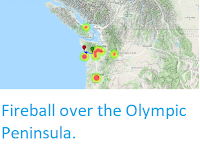Witnesses across southern Russia reported seeing a bright fireball
meteor (a shooting star brighter than Venus) on Thursday 21 June 2018,
according to the International Meteor Organization. The object apparently exploded over Lipetsk Oblast (Lipetsk State) at about 4.15 am local time, but witnesses have reported seeing it from as far away as Moscow. The object is estimated to have exploded with a force of about 3.2 kt TNT (roughly a fifth of the explosive power of the Hiroshima bomb), which suggests an object less than five metres across exploding more than 40 km above the ground.
Fireball meteor over Lipetsk Oblast on 21 June 2018. Катаклизмы и катастрофы природы./Youtube.
Fireball meteors are typically caused by pieces of rock burning up in
the atmosphere, but can be the result of man-made space-junk burning up
on re-entry. Objects
of this size probably enter the Earth's atmosphere several times a
year, though unless they do so over populated areas they are unlikely to
be noticed. They are officially described as fireballs if they produce a
light brighter than the planet Venus.
The brightness of a meteor is caused by friction with
the Earth's atmosphere, which is typically far greater than that caused
by simple falling, due to the initial trajectory of the object. Such
objects typically eventually explode in an airburst called by the
friction, causing them to vanish as an luminous object. However this is
not the end of the story as such explosions result in the production of a
number of smaller objects, which fall to the ground under the influence
of gravity (which does not cause the luminescence associated with
friction-induced heating).
These 'dark objects' do not continue along the path
of the original bolide, but neither do they fall directly to the ground,
but rather follow a course determined by the atmospheric currents
(winds) through which the objects pass. Scientists are able to calculate potential trajectories for hypothetical dark
objects derived from meteors using data from weather monitoring services.
See also...
Follow Sciency Thoughts on Facebook.







